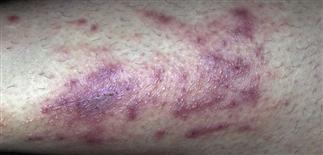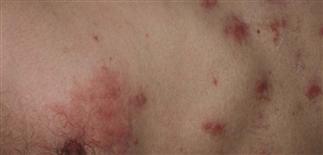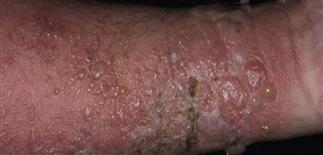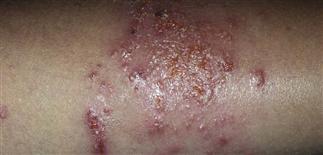Rhus dermatitis (poison ivy, poison oak, poison sumac)

Allergic contact dermatitis to poison ivy is often arranged in linear streaks. Not all the dermatitis will appear this way, but vesicles in a linear distribution suggest plant contact dermatitis.

Poison ivy, oak, and sumac share common allergenic catechols called urushiols. The dermatitis they cause is intensely pruritic and can erupt over several weeks.

Severe poison ivy. Intact and collapsed bullae on intensely erythematous skin on the forearm.

Dried urushiol on the skin may leave behind a telltale black ink-like mark.
DESCRIPTION
Poison ivy, oak, and sumac (Anacardiaceae family, Toxicodendron genus) are the most common causes of allergic contact dermatitis in the USA; they are rare in Europe. Related plants grow in South-East Asia, and Central and South America. The plant oleoresin (lipid-soluble portion) contains highly allergenic catechol chemicals (urushiols).
HISTORY
• Contact with leaf, stem, or root causes eruption within 8–72 h of exposure in a previously sensitized individual, 12–21 days for a person not yet sensitized (primary sensitization). • Primary allergic sensitization can result from plant exposure. After sensitization, repeat exposure causes the rash more promptly. • About 80% of American adults develop the rash if exposed; 30–40% require prolonged exposure. About 10–15% will not become sensitized. • Not spread by blister fluid or person to person.
PHYSICAL FINDINGS
• Findings vary with oleoresin contact quantity, pattern of contact, individual susceptibility. • Pruritic, edematous, linear erythematous streaks, usually with vesicles and large bullae on exposed skin. • Airborne particulate matter from burning plant can cause intense facial erythema and marked edema; eyelids can be dramatically swollen. • One clue is a temporary black mark, from dried and oxidized urushiol, on exposed skin. • Rash duration 10 days to as long as 3 weeks.
TREATMENT
• Wash skin with soap to inactivate and remove allergic oleoresin. Most effective if done within 15 min of exposure. • Cleanse exposed clothing and tools with soapy water. • Short, cool tub baths, with or without colloidal oatmeal (Aveeno), are soothing. • Calamine lotion helps control itching. • Oral antihistamines (hydroxyzine or diphenhydramine) may alleviate itching. Best at night to promote rest and offer itch relief. • Cool tap water or Burow’s solution compresses highly effective during blistering stage. Apply for 15–30 min several times a day for 1–4 days until blistering and severe itching controlled. Tap water cool compresses useful for severe facial or eyelid edema. • A medium-potency topical steroid (group II–V) is generously applied after wet dressing. If periorbital skin involved, a weaker topical steroid (group VI–VII) is advised for limited duration (twice daily for 7 days). • For severe, widespread inflammation, oral prednisone 0.75–1 mg/kg q.d. every morning, slowly tapered over 3 weeks. • Ivy Block barrier cream can prevent or lessen dermatitis, but must be applied before plant contact.







